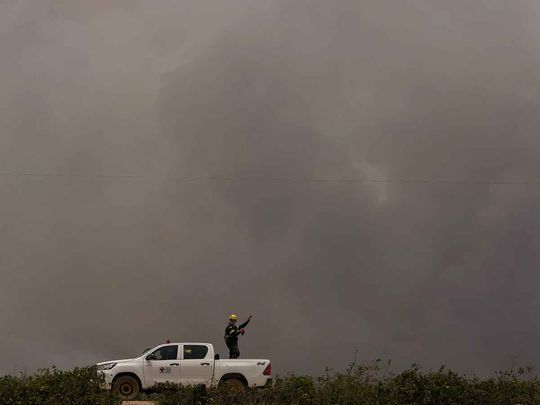
The heat in Rio de Janeiro, a city of nearly 7 million people, has proved disruptive and deadly. During sweltering temperatures Friday night, a woman died at a Taylor Swift concert. It was so hot Saturday that Swift postponed her concert scheduled for that night. "The safety and well-being of my fans, fellow performers and crew has to and always will come first," read a message posted to Swift's Instagram story on Saturday afternoon.
Even though it's still spring in the Southern Hemisphere, temperatures have climbed well above what's typical even in summer, which is more than a month away.
A stagnant area of high pressure, El Nio and human-caused climate change have converged to generate this excessive heat.
How hot it's been
Rio has seen a suffocating combination of heat and humidity for days. On Friday, when the woman died at the Taylor Swift concert, midday temperatures topped 100 and dew points, a measure of humidity, were in the upper 70s. Any dew point over 75 degrees is oppressively humid.
At a dew point of 77, about 23 grams of water, or about 1.55 tablespoons, are present in every cubic meter of atmosphere. That's the weight of roughly nine pennies.
Heat indexes on Friday - a measure of how it feels factoring in humidity - exceeded 120 degrees. Climate historian Maximiliano Herrera tweeted the heat index reached as high as 137 degrees in Rio's suburbs Saturday.
Why is it difficult to regulate body temperatures?
The higher the heat index, the less sweat can evaporate off our bodies. That's because the air is already closer to its moisture-storing capacity. At high heat indexes, less heat can evaporate from our skin and cool us down as a result. That can lead to difficulties in regulating our body temperatures. If left unchecked, heat exhaustion and heat stroke can occur.
Saturday's temperatures around Rio were both dangerously high and record-setting. Rio's Jacarepagu-Roberto Marinho Airport reported a heat index of 131 degrees on Saturday morning, the product of a temperature nearing 97 degrees and a dew point of 86. Most of the city's other airports saw high temperatures between 105 and 107 degrees.
According to Herrera, the town of Seropdica, a suburb about 25 miles west-northwest of Rio and 15 miles inland, hit 108.7 degrees, a November record.
Red alerts in 3,000 towns and cities
Record-high temperatures also spread into Peru and Bolivia. On Saturday, highs of 102.6 in Tingo de Ponaza, Peru and 102.2 degrees in Cobija, Bolivia set November records, according to Herrera.
The heat first moved into Brazil about a week ago. The BBC reported that red alerts were issued for nearly 3,000 towns and cities because of "unbearable" heat. On Nov. 12, it said, Rio hit 108.5 degrees, a record for the month.
The intensity of the heat is forecast to ease some after Sunday but, on balance, temperatures are predicted to remain warmer than normal through the next week in central South America.
What's driving the heat
Contributing to the heat has been counterclockwise-spinning surface high pressure system just offshore of Brazil. That's induced warm, humid northerly winds, pumping in the same kind of humidity characteristic of the Amazon rainforest. There's also a "heat dome," or ridge of hot, sinking air at higher altitudes. While deflecting away the jet stream and any inclement weather and cloud cover, it's promoting hot sunshine.
The heat is also being boosted by a strengthening El Nio, the climate pattern associated with warmer-than-normal ocean waters in the tropical Pacific Ocean.
Furthermore, the frequency, intensity and duration of extreme heat events, like this one, are increasing because of human-caused climate change. The planet just observed its warmest 12-month period on record and the last five months have all been the warmest observed.
According to the United Nations, Brazil has warmed by 0.9 degrees during just the past few decades. Land use changes, including deforestation of the Amazon, is expected to accelerate that pace of warming.











